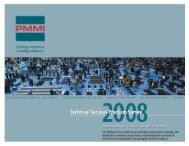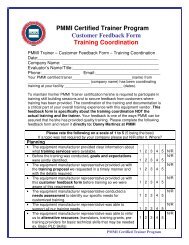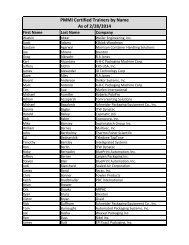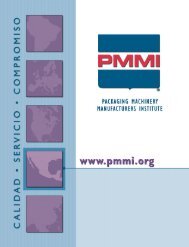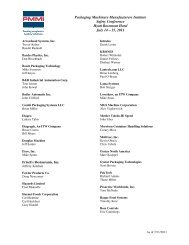Canadian Packaging Machinery Market Research Report - PMMI
Canadian Packaging Machinery Market Research Report - PMMI
Canadian Packaging Machinery Market Research Report - PMMI
You also want an ePaper? Increase the reach of your titles
YUMPU automatically turns print PDFs into web optimized ePapers that Google loves.
3.5 FOOD PACKAGING REGULATIONS<br />
On January 1, 2003, new regulations were published in Canada that will require<br />
mandatory nutrition labeling on most prepackaged food. The new regulations will<br />
require most food labels to carry a mandatory Nutrition Facts table listing Calories<br />
and 13 key nutrients. Under the new regulations, producers of prepackaged foods<br />
will have to declare the number of Calories and the amount of fat, saturated and<br />
trans fats, cholesterol, sodium, carbohydrates, fiber, sugars, protein, vitamins A and<br />
C, calcium, and iron in a specified amount of food. Some foods and beverages are<br />
exempted from the new labeling requirements, for example, alcoholic beverages,<br />
fresh fruit and vegetables, raw single ingredient meat and poultry (except ground<br />
meat and poultry), and raw single ingredient fish and seafood. While it is expected<br />
that some manufacturers will start to place the Nutrition Facts tables on their labels<br />
almost immediately, the food industry has been given three years to comply with the<br />
new Regulations. Small businesses, which are companies with less than one million<br />
dollars in annual sales revenue, have been given five years to comply.<br />
The Nutrition Facts tables must appear in a standard format so it looks the same<br />
from one product to another, making it easier to find and use. The tables will be<br />
printed in a clear, readable, type, making the information easy to use. The<br />
regulations allow manufacturers to use a horizontal format when there is not enough<br />
room on a package for the standard format and a linear format may be used on<br />
smaller packages. For smaller packages, the Nutrition Facts table may appear on the<br />
inside of the label, on an insert or on a tag. For very small packages, at least a postal<br />
address or a toll-free number must be provided.<br />
The <strong>Canadian</strong> Food Inspection Agency is responsible for enforcing the new nutrition<br />
labeling regulations. The Regulations amending the Food and Drug Regulations<br />
pertaining to nutrition labeling, nutrient content claims and health claims can be found<br />
in Acrobat (pdf) file format at http://www.hc-sc.gc.ca/hpfb-dgpsa/onpp-bppn/labellingetiquetage/regulations_e.html.<br />
A Compendium of Templates for "Nutrition Facts"<br />
Tables is available in Acrobat (pdf) file format at http://www.hc-sc.gc.ca/hpfbdgpsa/onpp-bppn/labelling-etiquetage/nutrition_fact_labels_cp_e.html.<br />
The<br />
Compendium is for illustrative purposes only, and it includes 270 templates that<br />
correspond to the full size graphic illustrations of the various versions of the Nutrition<br />
Facts table permitted by the Food and Drug Regulations on Nutrition Labeling. These<br />
templates will assist label designers and members of the food and packaging<br />
industries in complying with the format specifications of the Regulations.<br />
SMG/Columbia Consulting Group Page 34



